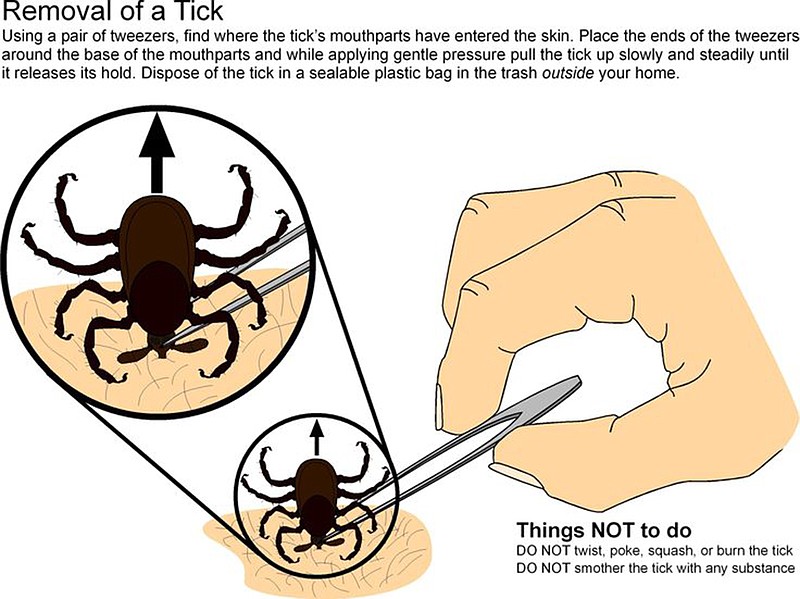Everyone dreads the tickle of a tick crawling up one's leg.
Tick season has arrived, and they're out in force, Missouri Department of Conservation agent Stephen Kistner said.
"People say that (it's a bad tick year) every year, but there's just ticks," he said. "I don't know that it's any worse than any other year. There's just a lot of ticks. All I know about is that I have to deal with them."
How bad a tick season will be is hard to predict, according to the U.S. Centers for Disease Control. A tick's life cycle lasts several years and many factors can impact the tick population in a given year.
However, they thrive in warm, humid and wet weather. They also tend to boom when their food sources (such as mice and deer) do.
Tick diseases
Missouri is a tick disease hot-spot, according to the Missouri Department of Health and Senior Services.
The list of tickborne diseases reported in Missouri is long: Rocky Mountain spotted fever, ehrlichiosis, tularemia, Heartland virus, Bourbon virus, Lyme or a lyme-like disease and the southern tick-associated rash illness (STARI).
Tickborne disease research is still a developing field, with many diseases being discovered within the last 30 years. The U.S. Centers for Disease Control is currently studying how tick bites may trigger alpha-gal allergy, which causes people to develop an allergy to mammalian meat (pork, beef, lamb and so on). Cases have been reported in Missouri.
Ticks pick up diseases while feeding on infected animals, such as deer or birds. They can later pass those diseases to humans through their saliva. Ticks must feed multiple times during their life cycle, and some species prefer particular animals at particular stages of their growth.
Luckily for humans, not every single tick harbors diseases. However, the longer a tick remains attached, the more likely it is to transmit any disease it may carry.
After noting a tick bite on yourself or a family member, keep an eye out for these symptoms (cdc.gov/ticks/symptoms) in the following weeks:
Fever and chills (associated with many tick-borne diseases)
Aches and pains, including headaches and muscle aches. Lyme disease is associated with joint pain.
Rashes: Lyme disease is often associated with a bulls-eye-like rash beginning at the site of the bite, which may feel warm to the touch. STARI starts with a bulls-eye shaped rash as well. Rocky Mountain Spotted Fever is sometimes associated with flat pink itchy spots, and tularemia often causes an ulcer at the bite's site, plus swollen lymph nodes.
Paralysis: Tick paralysis is a rare disease apparently caused by a neurotoxin in tick saliva. The tick may be attached for several days before paralysis kicks in, but once it starts (usually in the lower extremities), the paralysis spreads rapidly throughout the body. Severe complications include respiratory failure and death. Treatment involves simply removing the tick, including all its mouthparts; the paralysis wears off within 24 hours.
According to the CDC, early treatment of tickborne diseases is key to avoiding the worst complications, so visit your doctor immediately if any of these symptoms show up following a tick bite.
Tick safety
The best way to avoid tickborne diseases is to avoid being bitten by ticks. In Missouri, of course, that's easier said than done, but here are the basics from the CDC and MDH.
Stick to the center of well-cleared trails and avoid brushing against brush and tall grass. Ticks hunt by hanging onto foliage with legs extended and waiting for their meals to bump into them; they don't actually jump or fall from trees.
Wear close-fitting, long-sleeved clothing and tuck your pant cuffs into your socks.
"You want to limit the access into your clothing," Kistner said.
Light-colored clothing makes it easier to spot small ticks.
Use a DEET-based insect repellent, which interferes with ticks' ability to sniff you out, and/or treat your clothes with permethrin. Permethrin lasts through multiple washes and kills ticks on contact, but keep permethrin-treated clothes away from cats.
"Permethrin's really the best," Kistner said. "That's what I use."
Do a "tick check" on yourself and your young children after going outside. Use a mirror if necessary. Ticks can latch on anywhere, but favor the waistline, groin, underarms and behind the knees, neck and head.
"Anywhere where your clothes give a constriction, that's where they like to get," Kistner said.
Check Fido too - pets often carry ticks into the house.
Tumble-dry clothes worn outdoors on high heat for 10 minutes to kill any stowaways.
"Lint rollers work really well for taking them off while they're still crawling on your clothes," Kistner added.
If you find an attached tick, there's only one good way to remove them, according to the CDC. Use a set of tweezers or a commercial tick removal tool (like a tick key) to grasp the tick as close to your skin as possible. Then, slowly steadily pull it straight away from the skin until it releases. Disinfect the bite promptly.
"If you can catch them before they've been on there for 24 hours, you avoid most of the illnesses," Kistner said. "Early detection is really important with ticks."
Other methods of tick removal, like twisting or trying to suffocate ticks, run the risk of leaving behind mouthparts (which can cause infections) or making the tick vomit into the wound, which hastens the spread of bacteria.

